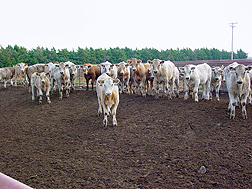The latest research says about 2% of all cattle, including those in feedlots and those on pasture, may be supershedders,” a term scientists have coined to describe cattle which turn out high levels of pathogenic organisms.
 Findings from studies by researcher Terrance M. Arthur and his colleagues at the USDA Agricultural Research Service Roman L. Hruska US Meat Animal Research Center in Clay Center, Neb., hope to provide a scientifically sound basis for new and effective strategies to curb shedding of this bacterium.
Findings from studies by researcher Terrance M. Arthur and his colleagues at the USDA Agricultural Research Service Roman L. Hruska US Meat Animal Research Center in Clay Center, Neb., hope to provide a scientifically sound basis for new and effective strategies to curb shedding of this bacterium.
Arthur and his co-workers have designed and conducted studies of 6,000 head of feedlot cattle and more than 13,000 manure, hide and carcass samples. To discover more about supershedding, Arthur and his colleagues gathered data representative of the entire U.S. cattle population to estimate the incidence of supershedding. Their analysis determined an average incidence of 2%.
ARS says this team was the first to show that in supershedders, E. coli O157 colonization may occur not just in the lower digestive tract but throughout the entire digestive system.
Scientists generally agree a supershedder is any animal that sheds 10,000 pathogenic organisms per gram of manure.
“It isn’t the amount of manure that’s shed; it’s the amount of the pathogen in the manure,” Arthur says.

